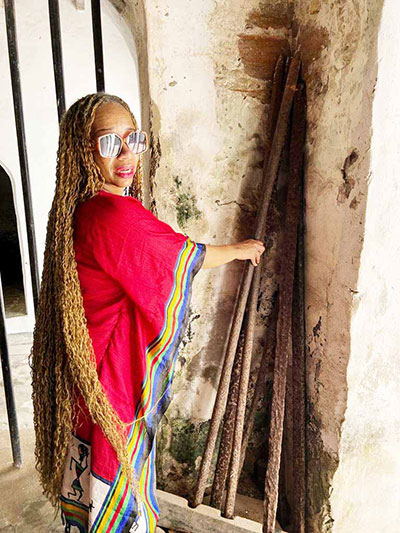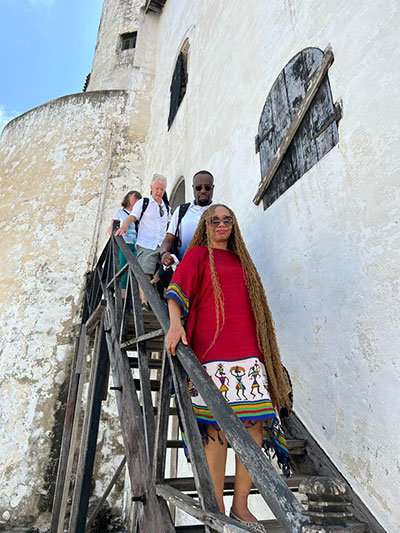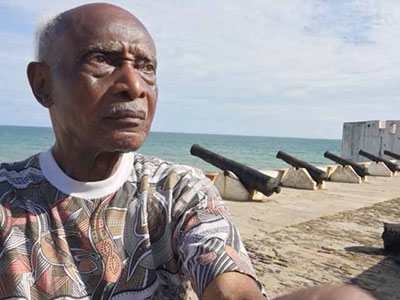FRANCIS Quamina Farrier is one of the people who is closely following my journey on the continent of Africa. Uncle Francis has traversed this Motherland, and has a lot to share. I particularly asked him to share his story on Elmina Castle.
“It was dark; really dark when the lights were switched off in the dungeon where the tourists were. It was to give us the actual experience of one aspect of the Atlantic Slave Trade; it was also to give us an idea of what happened to those who were held captive and waiting to be shipped across the Atlantic Ocean from Africa to countries in the Western Hemisphere, where they were sold into slavery. There was a muffled gasp from members of the touring group as we were, in a way, taken back in time to the era of the Atlantic Slave Trade from West Africa.
 In more recent times, the dungeons have been transformed into tourist attractions of a sad nature. The deep darkness lasts for only a minute or so, after which the lights are switched on again. However, it enters the experience of tourists who many times shed tears as the tour guide gives a historical commentary about the suffering of those who were actually held captive in those dungeons. It is difficult for most tourists who visit those dungeons not to have a measure of emotional stress while having that very brief experience of being in a pitch-dark dungeon, where it is even difficult to see the other persons who are around you.
In more recent times, the dungeons have been transformed into tourist attractions of a sad nature. The deep darkness lasts for only a minute or so, after which the lights are switched on again. However, it enters the experience of tourists who many times shed tears as the tour guide gives a historical commentary about the suffering of those who were actually held captive in those dungeons. It is difficult for most tourists who visit those dungeons not to have a measure of emotional stress while having that very brief experience of being in a pitch-dark dungeon, where it is even difficult to see the other persons who are around you.
More recently, on the outer side of the “DOOR OF NO RETURN” in Ghana, the following sign has been written: “DOOR of RETURN”. That sign is an invitation for Africans in the Diaspora and others to visit these castles and tour those historic dungeons. Ghana, in particular, has kept those dungeons as lessons and experiences for the many thousands who travel from near and far to see them. They are now “Tourist Attractions” of a painful type. They invoke deep emotions for many tourists, who think about what it was like for those who were uprooted from the shores of Africa and taken to countries in the Western Hemisphere, where they were enslaved, for centuries.
The experience with the closed doors was jolting for me. The sound of the doors locking is still aching in my ears. I stood there trying to imagine what that must have felt like for an extended period, but could not. Kweku and Kofi accompanied me on this tour, but it was their first time. Kweku gave her comment last week, and Kofi gave a different perspective. He captured the videos and photos for the trip. “The first time I visited the castle, the smell lingered in my nostrils for some time. I tried to comprehend how sometimes this heinous act could have been part of our history. This trip was different, because I saw it through your eyes, Sonia, and felt it through your emotions. It penetrated deeper than I anticipated.”
His comment made me even more aware of how our emotions and energy can affect people in a negative and positive way. I tried, but could not control my emotions. At one time, I put back against the wall and closed my eyes to put faces to the figures I imagined. A chill went through my body when I held the original iron bars that were used in the dungeons.
Ester Adams, who is a Guyanese that lives in the US, also shared her experience.
“In amazement, I listened to the brief history of the castle while walking around the perimeter. Standing in the centre of the castle grounds and being told that the Portuguese captains prayed in the name of God to bless the slave ships, their journey, and cargoes made me question God, like how and why and for what reason.

The first stop was the dungeon where they held the captive slaves. As Koffee explained, the floor was so full of faeces over the years of captivity, that it had to be excavated. In the hot box is a natural sauna with a stench floating around.
The next room was where they held the misbehaved slaves; no window. And this room was lower than the others. When the door closed, there was hardly any air flowing in the room. On the walls, to date, you can see the dying claw marks made by the suffocating slaves.
The last stop was the holding area, which is called The Door of No Return. It was high tide when we made the visit. We were asked to exit. Then we were welcomed back to the Motherland. The waves crashed on the beach as I looked to the peaceful horizon, with Koffee’s voice explaining how many tossed themselves overboard. As I exited, the tears flowed to know my fore-parents endured such an excruciating experience and survived so that I can have so much privilege that I don’t take anything I’m given or achieve for granted anymore.”
Eric Phillips lived on the Continent of Africa, and always encouraged me to visit. I am happy I finally did. He shared his experience.
“My trip to the Castle was a watershed event for me. As a student of history, especially African history, and as someone who has visited 40 African countries and lived in South Africa for 7 1/2 years, my visit was a cleansing event that made me stronger and more at peace with myself. It reinforced the greatness of our people. Even after suffering a holocaust and European occupation and colonisation, we continue to rise. I hope every African person gets the opportunity to touch African soil, so that their spirit can be grounded, and their lives re-oriented.”
Kenneth Rampersaud said, “A Memorable and Emotional Experience at the Elmina Castle in Ghana, Africa. Even after centuries, the stench of slave dungeons took me by surprise; a scent I will never forget. Imagine slaves were kept in a cramped and filthy cell with hardly any ventilation. There was no space to lie down, and some died while standing.
As an Indo-Guyanese, it was a great honour to visit this historical castle, and it still gives me goosebumps to date. I urge my compatriots to make a visit if possible.”
My sister, Raquel, had recommended that it was a must-visit place in Ghana, and she was correct. “It was a privilege to visit the Elmina Castle in 2011. A deeply emotional experience of a sad time in history, but one that connects us with our heritage in a deep sense. Every Caribbean citizen should experience this,” she said.
We will be hosting a night of storytelling when I return, and if you are interested, WhatsApp 628-9044 for more ‘info’ as we celebrate this beautiful journey called life BEYOND THE RUNWAY.



.jpg)








